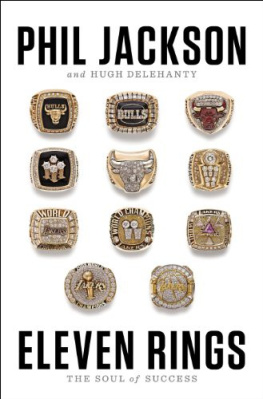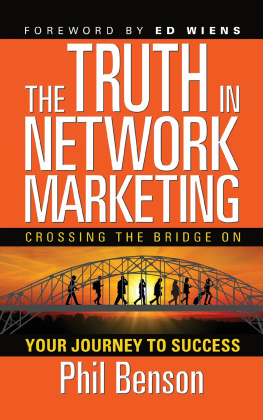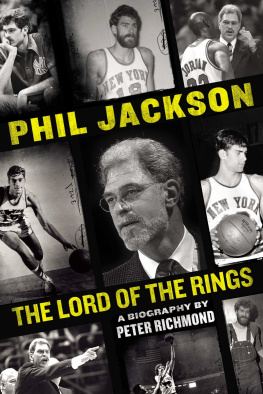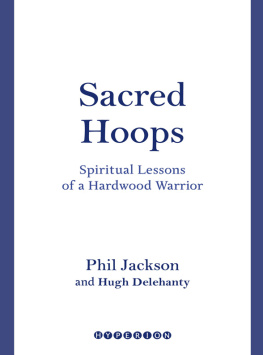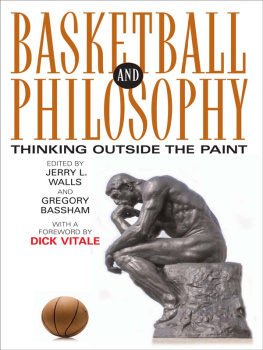ALSO BY PHIL JACKSON
Journey to the Ring
The Last Season (with Michael Arkush)
More Than a Game (with Charley Rosen)
Sacred Hoops (with Hugh Delehanty)
Maverick (with Charley Rosen)
Take It All!
THE PENGUIN PRESS
Published by the Penguin Group
Penguin Group (USA) Inc., 375 Hudson Street,
New York, New York 10014, USA
USA Canada UK Ireland Australia New Zealand India South Africa China
Penguin Books Ltd, Registered Offices: 80 Strand, London WC2R 0RL, England
For more information about the Penguin Group visit penguin.com
Copyright Phil Jackson, 2013
All rights reserved. No part of this book may be reproduced, scanned, or distributed in any printed or electronic form without permission. Please do not participate in or encourage piracy of copyrighted materials in violation of the authors rights. Purchase only authorized editions.
constitutes an extension of this copyright page.
ISBN 978-1-101-61796-0
Penguin is committed to publishing works of quality and integrity. In that spirit, we are proud to offer this book to our readers; however, the story, the experiences, and the words are the authors alone.
F OR R ED H OLZMAN, T EX W INTER, AND ALL THE PLAYERS I VE COACHED WHO HAVE TAUGHT ME SO MANY LESSONS.
CONTENTS
When you do things from your soul,
you feel a river moving in you, a joy.
RUMI
1
THE CIRCLE OF LOVE
Life is a journey. Time is a river. The door is ajar.
JIM BUTCHER
C ecil B. DeMille would have loved this moment.
Here I was sitting in a limo at the ramp leading into the Los Angeles Memorial Coliseum, waiting for my team to arrive, while an ecstatic crowd of ninety-five thousand plus fans, dressed in every possible combination of Lakers purple and gold, marched into the stadium. Women in tutus, men in Star Wars storm-trooper costumes, toddlers waving Kobe Diem signs. Yet despite all the zaniness, there was something inspiring about this ancient ritual with a decidedly L.A. twist. As Jeff Weiss, a writer for LA Weekly, put it: It was the closest any of us will ever know what it was like to watch the Roman Legions returning home after a tour of Gaul.
Truth be told, Ive never really felt that comfortable at victory celebrations, which is strange given my chosen profession. First of all, Im phobic about large crowds. It doesnt bother me during games, but it can make me queasy in less controlled situations. Ive also never really loved being the center of attention. Perhaps its my inherent shyness or the conflicting messages I got as a kid from my parents, who were both ministers. In their view, winning was finein fact, my mother was one of the most fiercely competitive people Ive ever metbut reveling in your own success was considered an insult to God. Or as they would say, The glory belongs to Him.
This celebration wasnt about me, though. It was about the remarkable transformation the players had undergone en route to the 2009 NBA championship. You could see it in their faces as they descended the long purple and gold staircase into the coliseum dressed in rally caps and championship T-shirts, laughing, jostling, beaming with joy, while the crowd roared with delight. Four years earlier the Lakers hadnt even made the playoffs. Now they were masters of the basketball universe. Some coaches are obsessed with winning trophies; others like to see their faces on TV. What moves me is watching young men bond together and tap into the magic that arises when they focuswith their whole heart and soulon something greater than themselves. Once youve experienced that, its something you never forget.
The symbol is the ring.
In the NBA, rings symbolize status and power. No matter how gaudy or cumbersome a championship ring may be, the dream of winning one is what motivates players to put themselves through the trials of a long NBA season. Jerry Krause, the former general manager of the Chicago Bulls, understood this. When I joined the team as an assistant coach in 1987, he asked me to wear one of the two championship rings Id earned playing for the New York Knicks as a way to inspire the young Bulls players. This is something I used to do during the playoffs when I was a coach in the Continental Basketball Association, but the idea of sporting such a big chunk of bling on my finger every day seemed a bit much. One month into Jerrys grand experiment the rings centerpiece rock fell out while I was dining at Bennigans in Chicago, and it was never recovered. After that I went back to wearing the rings only during the playoffs and on special occasions like this triumphant gathering at the coliseum.
On a psychological level, the ring symbolizes something profound: the quest of the self to find harmony, connection, and wholeness. In Native American culture, for instance, the unifying power of the circle was so meaningful that whole nations were conceived as a series of interconnected rings (or hoops). The tepee was a ring, as were the campfire, the village, and the layout of the nation itselfcircles within circles, having no beginning or end.
Most of the players werent that familiar with Native American psychology, but they understood intuitively the deeper meaning of the ring. Early in the season, the players had created a chant they would shout before each game, their hands joined together in a circle.
One, two, threeRING!
After the players had taken their places on the stagethe Lakers portable basketball court from the Staples CenterI stood and addressed the crowd. What was our motto on this team? The ring, I said, flashing my ring from the last championship we won, in 2002. The ring. That was the motto. Its not just the band of gold. Its the circle thats made a bond between all these players. A great love for one another.
Circle of love.
Thats not the way most basketball fans think of their sport. But after more than forty years involved in the game at the highest level, both as a player and as a coach, I cant think of a truer phrase to describe the mysterious alchemy that joins players together and unites them in pursuit of the impossible.
Obviously, were not talking romantic love here or even brotherly love in the traditional Christian sense. The best analogy I can think of is the intense emotional connection that great warriors experience in the heat of battle.
Several years ago journalist Sebastian Junger embedded himself with a platoon of American soldiers stationed in one of the most dangerous parts of Afghanistan to learn what enabled these incredibly brave young men to fight in such horrifying conditions. What he discovered, as chronicled in his book War, was that the courage needed to engage in battle was indistinguishable from love. Because of the strong brotherhood the soldiers had formed, they were more concerned about what happened to their buddies than about what happened to themselves. Junger recalls one soldier telling him that he would throw himself on a grenade for any one of his platoonmates, even those he didnt like all that much. When Junger asked why, the soldier replied, Because I actually love my brothers. I mean, its a brotherhood. Being able to save their life so they can live, I think is rewarding. Any of them would do it for me.
That kind of bond, which is virtually impossible to replicate in civilian life, is critical to success, says Junger, because without it nothing else is possible.

